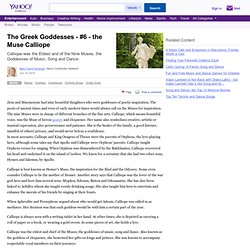

Meynier-charles-1768-1832-fran-calliope-muse-de-la-poesie-1106639.jpg (JPEG Image, 315 × 500 pixels) Charles+Coypel+(1694-1752)+la+muse+calliope.jpg (JPEG Image, 400 × 333 pixels) 220px-Calliope.jpg (JPEG Image, 220 × 282 pixels) The Greek Goddesses - #6 - the Muse Calliope. Zeus and Mnemosyne had nine beautiful daughters who were goddesses of poetic inspiration.

The poets of ancient times and even of early modern times would always call on the Muses for inspiration. The nine Muses were in charge of different branches of the fine arts. Calliope, which means beautiful voice, was the Muse of heroic poetry and eloquence. Her name also symbolizes creative, artistic or musical expression, also perseverance and patience. She is the healer of the family, a good listener, mindful of others' privacy, and would never betray a confidence. In most accounts, Calliope and King Oeagrus of Thrace were the parents of Orpheus, the lyre-playing hero, although some tales say that Apollo and Calliope were Orpheus' parents.
Calliope is best known as Homer's Muse, the inspiration for the Iliad and the Odyssey. When Aphrodite and Persephone argued about who would get Adonis, Calliope was called in as mediator. Calliope is always seen with a writing tablet in her hand. Sources: The Muses and Creative Inspiration: Homer to Milton - viewcontent.cgi. Encyclopedia Britannica. Microsoft Word - Skarsouli.doc - Skarsouli.pdf.
Goddess Information: The Muse Calliope. Calliope, sometimes spelled Kalliope (pronounced ka-LIE-oh-pee) , is Greek for “beautiful voicedâ€.

This is very appropriate for the eldest of the Muses. She is considered the inspiration for heroic or epic poetry such as Homer's Iliad and Odyssey as well as other epic poems such as Beowulf.According to the Encyclopedia Britannica, heroic poetry is a narrative verse that has an elevated mood to create excitement and drama. It is meant to excite and create enthusiasm to those who hear it.
It takes you on a journey through the battle and through the adventure.Traditionally it is in the form of a song accompanied by a stringed instrument. This of courselets us know it is part of Bardic history. Colors: Red, Gold, Blue, Light Brown, Orange, Ivory Symbols: Stringed instruments, Quill and parchment, Golden crown, Books, Scrolls, Sword Scents/Herbs: Orange, Lemon, Dragon's Blood, Spearmint, Clove, Carnation.
Muses in Greek Mythology- the Greek Muse Calliope. Calliope. Calliope. Detail of painting The Muses Urania and Calliope by Simon Vouet, in which she is holding a copy of the Odyssey In Greek mythology, Calliope (/kəˈlaɪ.əpiː/ kə-LY-ə-pee; Ancient Greek: Καλλιόπη, Kalliopē "beautiful-voiced") was the muse of epic poetry,[1] daughter of Zeus and Mnemosyne, and is believed to be Homer's muse for the Iliad and the Odyssey .[2] Calliope is usually seen with a writing tablet in her hand.

At times, she is depicted as carrying a roll of paper or a book or as wearing a gold crown. The Italian poet, Dante Alighieri, in his Divine Comedy, makes reference to Calliope, "Here rise to life again, dead poetry! Let it, O holy Muses, for I am yours, And here Calliope, strike a higher key, Accompanying my song with that sweet air which made the wretched Magpies feel a blow that turned all hope of pardon to despair. " References[edit] Jump up ^ Lempriere, D.D., 1788. External links[edit]